

Electricity compensates for bok choy yield loss in agrovoltaic systems.
Sustainable Agriculture Student Research Project
Using Agrovoltaics to Shade Bok Choy Variety TrialAmanda Tam, Department of Sustainable Agriculture, 2023 |
Introduction
Bok choy (Brassica rapa subsp. chinensis), also known as Pac choi, is an Asian brassica crop. As a cool season crop, one challenge with growing it is that high temperatures in the height of summer can induce bolting (flower initiation). This causes physiological changes resulting in the vegetable becoming bitter in taste (Nair et al. 2015), making it unmarketable. Kalisz et al. (2012) observed that there was an interaction between Bok choy cultivar and the growing period on yield, which aligns with the assertion by Siomos (1999) that genotype and temperature are the major factors that affect bolting. For the bioregion of Southwestern BC, this study aimed to compare five Bok choy varieties (Bopak, Chun Mei, Joi Choi, Mei Qing Choi, and Summer Zest) on their bolt resistance and marketable yield across two different plantings – in June and in August – which was expected to differ in ambient temperature.
Additionally, shading is expected to contribute to bolt resistance and the yield in Bok choy. Shading would contribute to lowering microclimatic ambient temperature but would also lower light irradiance which could negatively affect crop yields. However, with crops that bolt easily due to high temperatures, there is potential of using a solar photovoltaic system to maximize crop yield while using the shading implement to capture solar energy. Thus, for the bioregion of Southwestern BC, this study also aimed to compare shading methods (‘solar panel,’ shade cloth, and unshaded control) on Bok choy bolt resistance and yield, to determine if the combination of a photovoltaic system with Bok choy is a compatible pairing.
This study had three overarching objectives:
- Objective 1: To determine the effects of variety, shading method, and planting date on Bok choy bolting and yield.
- Objective 2: To determine if there are interactions between variety and shading method, variety and planting date, & shading method and planting date on Bok choy bolting and yield.
- Objective 3: To compare the total output (Bok choy value and electrical value) from plots with and without the ‘solar panels.’
Methods
- Location: KPU Farm, Richmond, BC
- Duration: May 16, 2023 – August 20, 2023
- Land Use: 3 m x 30 m
- Randomized Complete Block Split-Plot Design with 3 replications
- Plot: Shading Method
- Subplot: Latin Square Design of 5 Varieties with 5 replicates

- Each plot had a sensor unit consisting of three different sensors to measure ambient temperature, light, and soil moisture.
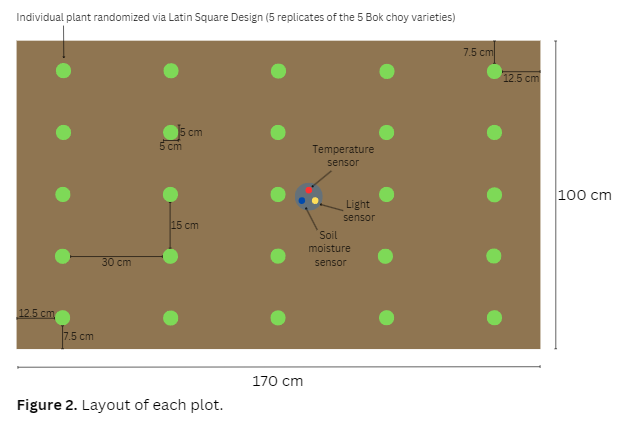
- ‘Solar Panel’ = 1 m x 1.7 m plywood with additional light sensor in the center
- Angled at 54° from vertical
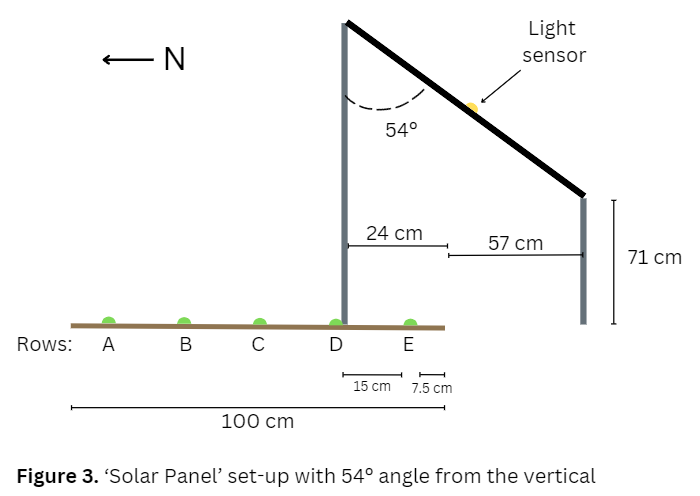
- Shade Cloth: 50% green shade cloth laid atop 3 hoops
- Bok choy:
- Varieties: Bopak, Chun Mei, Joi Choi, Mei Qing Choi (check variety), Summer Zest
- Seeded indoors at day 0 (May 16, 2023 & July 11, 2023)
- Transplanted outdoors at day 17 (June 2, 2023 & July 28, 2023)
- ProtekNet (89% light transmission; 62% porosity) for 7 days
- Weeded weekly
- Irrigated via drip irrigation 3 times/week
- Harvested at day 40 (June 25, 2023 & August 20, 2023)
- Data Collection:
- Throughout study: Ambient temperature, light irradiance (both on the panels & in the plots), soil moisture (although sensors only worked properly for August planting)
- Light sensor data was used to calculate the estimated amount of electricity the panels would generate in kWh
- If bolting occurred: days to bolting from sowing date
- On harvest day: yield in fresh weight (lb.) and marketability rating (1: not at all marketable; 5: topnotch quality) – both combined into marketable yield (lb.) unit
- Throughout study: Ambient temperature, light irradiance (both on the panels & in the plots), soil moisture (although sensors only worked properly for August planting)
- Data Analysis: Microsoft Excel and Mixed Model Analysis in the jamovi interface for R
- Dependent variable: Marketable Yield (lb.)
- Factors: Planting, Row, Shade Method, and Variety
- Cluster variables: Block, Column, and Plot
- Fixed Effects: Planting, Row, Shade Method, Variety, and their respective two-way interactions
- Random Effects: Block-Intercept, Column-Intercept, and Plot-Intercept
- Bonferroni was conducted as the post-hoc test to determine statistically significant difference between the means (p < 0.05)

Results
Solar panel plots had lower ambient temperature from 8:00 am to 7:59 pm compared to the control plots, while shade cloth plots had higher ambient temperature from 9:00 am to 5:59 pm compared to the control plots (Figure 5).
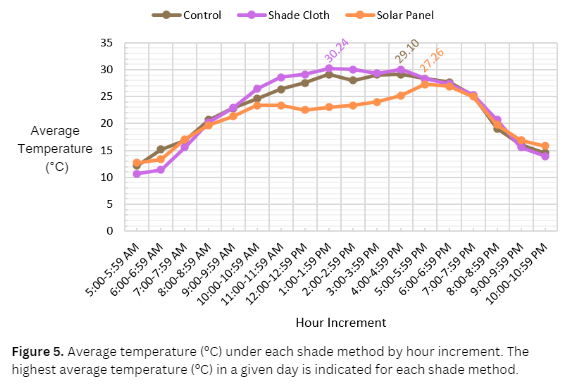
- Control plots had the lowest daily average soil moisture (% saturation), followed by the Solar Panel plots, then by the Shade Cloth plots which had the highest average soil moisture (Figure 6).

- The light data indicated that the actual panels were estimated to produce the most electrical energy (kWh) over the course of the 23 days the Bok choy plants were outdoors from Transplant to Harvest days (Figure 7, Table 1).
- According to BC Hydro (n.d.), the average net metering price for electricity is CAD$0.06/kWh. Thus, each panel was estimated to produced CAD$0.66 worth of electricity over the span of 23 days in August.
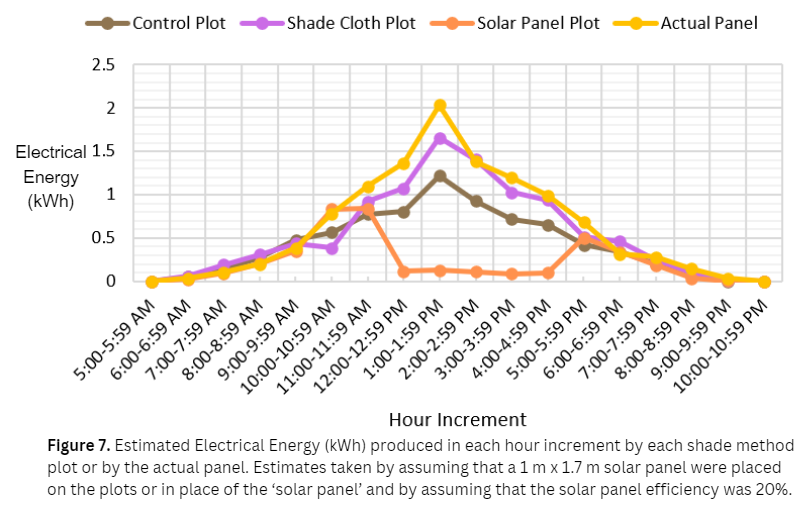
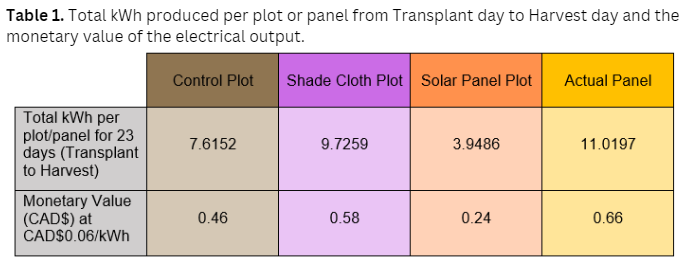
- None of the Bok choy plants in either of the plantings experienced bolting during this study
- No statistically significant difference in Marketable Yield (lb.) means according to Shade Method, Planting Date, Shade Method * Variety interaction, Row * Variety interaction, and Variety * Planting Date interaction.
- Means for Marketable Yield (lb.) according to Shade Method still used to calculate average yield loss of Bok choy under each solar panel (Table 2):
- Average marketable yield loss under a solar panel = (marketable yield of control plots – marketable yield of solar panel plots) * price/yield
- (0.324 lb. – 0.249 lb.) * CAD$6/lb. = CAD$0.45
- Means for Marketable Yield (lb.) according to Shade Method still used to calculate average yield loss of Bok choy under each solar panel (Table 2):

- The row Bok choy grew in had a significant effect on marketable yield (lb.) and was included in the statistical analysis.
- The Mixed Model Analysis indicated that there was a statistically significant difference in Marketable Yield (lb.) means according to Variety, Row, Shade Method * Row interaction, Shade Method * Planting Date interaction, and Row * Planting Date interaction.
- None of the other varieties had a significantly different marketable yield (lb.) than the check variety, Mei Qing Choi. Chun Mei and Joi Choi were the only varieties that had statistically different marketable yield (lb.) (Figure 8).
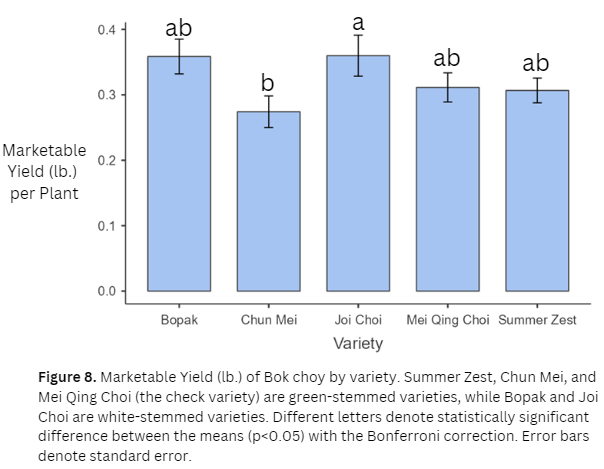
- According to row, rows A and B had significantly higher marketable yield (lb.) than rows C, D, and E (Figure 9).
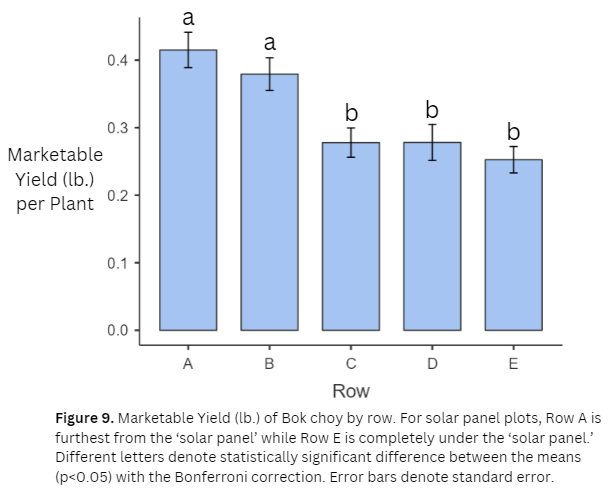
- There was also an interaction between shade method and row, because different patterns emerged by row when split by shade method (Figure 10).

- According to shade method by planting date interaction, there was a statistically significant difference in marketable yield (lb.) between Control plots in June and Control plots in August (Figure 11).

- According to row * planting date interaction, again there is general trend of highest to lowest marketable yield (lb.) from rows A to E in the June planting (Figure 12).
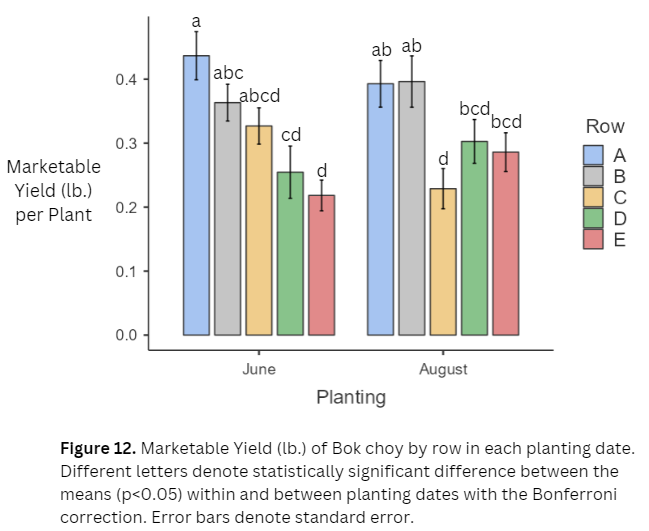
- The electrical output of a solar panel (CAD$0.66) compensates for the yield loss of Bok choy (CAD$0.45) from shading it with the solar panel.
- When converted to monetary value, Shade Cloth plots produced the highest total value, followed by Solar Panel plots, then the Control plots (Table 3).
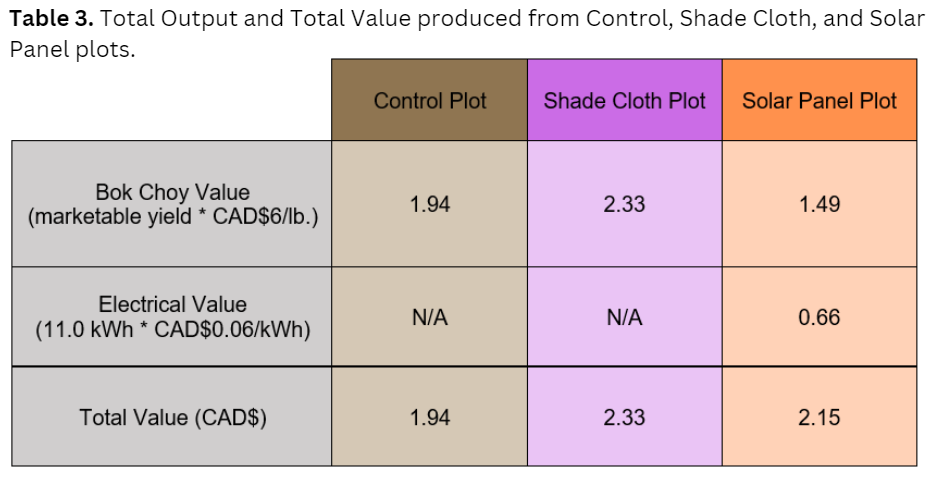
Conclusion
- Ignoring upfront cost of solar panel installation, theoretical energy output generated by the solar panel (CAD$0.66) was able to compensate for the yield loss of Bok choy shaded under the solar panel (CAD$0.45).
- At a practical level, shade cloth performed best:
- highest average marketable yield (although not statistically significant)
- highest total output in monetary value
- protection from bird and insect pests, & lowest visual presence of viral infection
- financially cheaper than solar panel material and installation